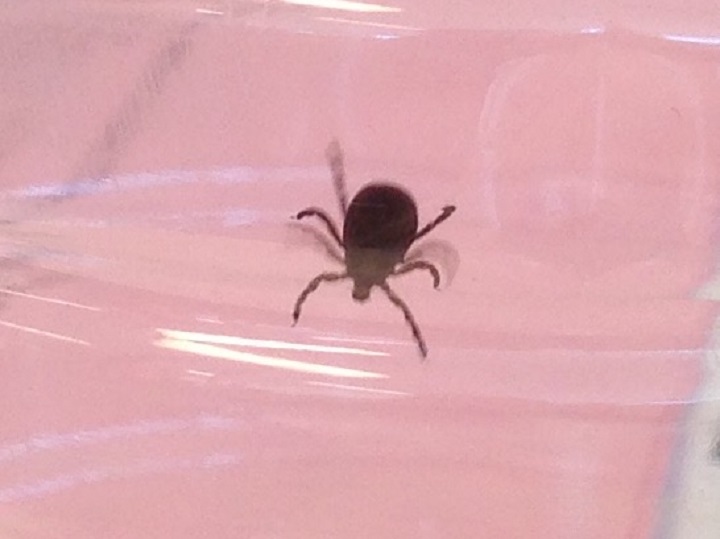Blacklegged ticks are slowly spreading to new parts of Canada, bringing Lyme disease with them, say public health researchers.

The number of Lyme disease cases has shot up across Canada over the last seven years, from 144 in 2009 to a high of 917 in 2015. Blacklegged ticks carry the bacteria that causes Lyme disease, and transmit it to humans through bites. So, more reports of Lyme disease are partly due to more awareness, but also due to more ticks.
Robbin Lindsay, a senior research scientist at the National Microbiology Laboratory of the Public Health Agency of Canada, studied blacklegged ticks for his PhD thesis in 1990. He travelled to Long Point, on Lake Erie in southern Ontario.
“I had to come from Manitoba and do my PhD in Ontario because there was no other population of these ticks to study,” he said.
“From that point, it spread to parts of southern, eastern and northwestern Ontario. It’s into Manitoba and spreading quite rapidly in that location. It’s found again through much of southern Quebec, especially in southwestern Quebec, and we still see focal populations in New Brunswick and Nova Scotia. None of that was occurring at the time I was a PhD student.”
For example, blacklegged ticks are relatively new arrivals to Ottawa, said Ann Stanton-Loucks, public health inspector with Ottawa Public Health. “There’s always been ticks, but there’s never been the particular kind of tick that causes Lyme disease.”
Last year, she said, 20 per cent of ticks tested positive for Lyme disease bacteria, which prompted the city to note it as an at-risk area for Lyme disease.
Spreading ticks
Ticks often first arrive in an area by air, said Lindsay, carried by migratory birds like robins and sparrows. But in order for them to survive and establish a population in their new location, certain conditions need to be met.
First, there need to be a lot of ticks flying in. “We think it’s probably a function of there being populations to the south of us that have built to the level where enough birds were coming in infested.”
“Bombard these areas with enough ticks, they will eventually stick in the environment.”

Secondly, the area needs to be warm enough to enable ticks to move through their various life stages, and in the end, breed and produce more ticks. If it’s too cold, he said, they have trouble doing this quickly enough.
Fortunately for the ticks, there has been a warming trend in regions where the ticks were being dropped. “Definitely climate warming was also a factor.”
The local vegetation and wildlife matters too, said Curtis Russell, a senior program specialist with Public Health Ontario. The ideal home for a tick is a deciduous forest, with lots of leaf litter on the ground and lots of hosts — like small mammals, deer or people — to feed on.
“These ticks are prone to desiccation or drying out, so they need leaf-litter matter to burrow down into when it gets too hot. So because of that, they need to be in brushy wooded areas or mixed deciduous forest, so that’s usually where we see them in Ontario.”

For that reason, Lindsay imagines that ticks’ expansion will be limited by the extent of the deciduous forest. Boreal forests, with lots of coniferous trees, aren’t really suitable for tick life. Similarly, places like Prince Edward Island, which doesn’t have deer, will likely not support significant tick populations.
Then again, most Canadians live closer to deciduous forests than boreal ones. “In terms of risk, these ticks don’t have to move very far to put a very significant portion of the Canadian population at risk of exposure,” said Lindsay.
Lyme weather
Although the general trend is for the number of Lyme disease cases to increase, they do move up and down somewhat from year to year. This can be due to specific weather conditions and human behaviour, said Russell.
The hot summer in Ontario in 2016 meant slightly fewer cases, he said. “That high heat and those temperatures are not always the best for those ticks, so they probably aren’t out as much. They’re staying down in the leaf litter. Also when it’s super-duper hot, people don’t tend to go out as much.”
And although a cold, rainy year might be better for ticks, people aren’t out hiking as much, so likely get fewer bites.
How to protect against ticks
Public health officials like Stanton-Loucks still encourage people to spend time outside enjoying nature. But, they advocate a few simple precautions.
- Wear long, light-coloured clothing
- Tuck your pants into your socks
- Wear insect repellent with DEET on clothing and exposed skin
- Do a “tick-check” when you get home and carefully inspect yourself for ticks
- Shower or bathe after you get home to further check for ticks (and wash them down the drain if they’re not attached)
And if you do find a tick embedded in your skin, Stanton-Loucks says not to panic. It can be safely removed with tweezers. Hold the tweezers parallel to the skin and pull straight up, removing the entire tick. Don’t irritate the tick with fire, oil or anything else beforehand, she said.
“The reason being is, the bacteria that causes Lyme disease resides in the gut of the tick. And if you irritate the tick in some way, and it’s embedded in your skin, it will then regurgitate that bacteria directly into your skin and into your bloodstream.”
After removing the tick and thoroughly cleaning the area, she recommends visiting your doctor to see if any further action or treatment is required.




Comments